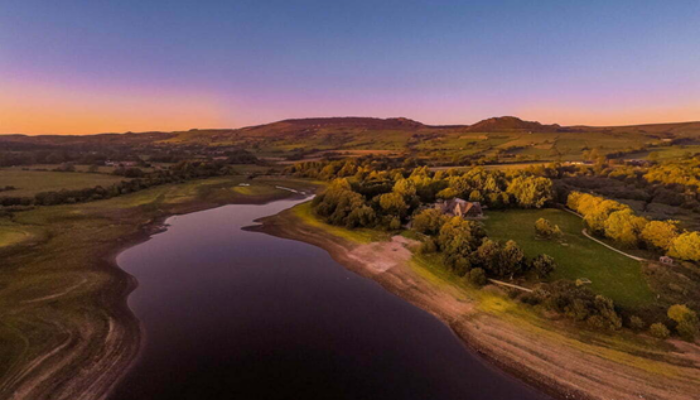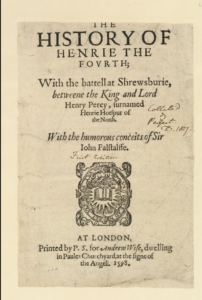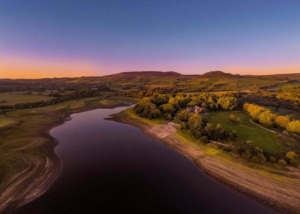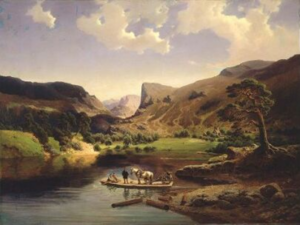
Recently, I was reading about the River Trent in the UK and came across a surprising Shakespeare quote that I thought I would highlight to the geomorphology community . The quote below is from Henry IV (Part 1, act 3, scene 1) where the character ‘Hotspur’ references the meandering River Trent:
“Methinks my moiety, north from Burton here,
In quantity equals not one of yours:
See how this river comes me cranking in,
And cuts me from the best of all my land
A huge half-moon, a monstrous cantle out.
I’ll have the current in this place damm’d up;
And here the smug and silver Trent shall run
In a new channel, fair and evenly;
It shall not wind with such a deep indent,
To rob me of so rich a bottom here.”
What I found fascinating was the description of a crescent or semi-circle shape in a river from such an early text (published in 1598 [Dates and Sources | Henry IV Part I | Royal Shakespeare Company, n.d.]), as well as the recognition that obstructing the river around its bend could force an avulsion, generating a new straight segment and a meander cut-off (and increasing Hotspur’s area of land as he gains everything on one side of the river).

The title page of the second edition of Henry IV Part 1 (https://shakespearedocumented.folger.edu/resource/document/henry-iv-part-1-first-edition)
Since coming across this Shakespeare quote, I’ve mentioned it to a few geoscientists who have excitedly shared with me similar instances where they’ve found reference to their research in some form of art: from the past few centuries of landscape painting all the way up to modern song lyrics (see below).
When you think about it, it is not that surprising that enjoyment of and interpretation of landscapes is not confined to purely scientific study, and I’m personally excited to use this as a way to communicate with and connect with students, fellow scientists and non-experts alike. See Tooth et al. (2016) for more on engagement with the arts for geomorphology outreach and teaching.
For now, I thought I would highlight some of the references to landscapes and geomorphology in the arts and throughout history that I have come across since my run-in with Shakespeare – ranging from the serious influence art has had on public perception of landscapes (scope for an entire field of study), to modern lyrics referencing the natural world which I include with more tongue-in-cheek attitude. Apologies for the UK/USA focus – if you have an example to share from other cultures and in other languages please comment below to share it with the geomorphology community! And watch this space for more blog posts as I continue to think about how landscapes have been and are described and interpreted in our cultures, outside of scientific study.
Inspired by how many artists use the natural world to metaphorise all manner of experiences, I am also taking suggestions for this Spotify Playlist of songs loosely referencing geomorphology (rivers, landscapes, mountains!), for those long field trip car rides. Please comment on this post or email me songs you’d like added!
References I’ve currently come across:
-
- The word meander actually derives from a real river – the winding river Menderes in South-West Turkey, of which the ancient Greek geographer Strabo said “…its course is so exceedingly winding that everything winding is called meandering.” [Roller, 2014].
- John Constable, the famous English romantic landscape painter made rivers and channels the subject of many of his works, e.g. The Haywain (though on researching landscape painters and geomorphology I came across an article exploring how the romanticised visualisation of human-altered landscapes might not be so positive – see Dixon, 2013).
- The Metropolitan Museum of Art in New York has a series exploring Native community member’s responses to Euro-American art, much of which focuses on landscapes and relationships to the natural world and colonialism.
- For those morphodynamics fans, David Bowie, in the song ‘Changes’ sings:
“I watch the ripples change their size,
But never leave the stream of warm impermanence” - Bob Dylan in ‘Blowing in the wind’ very pertinently proposes a great PhD topic:
“Yes, and how many years must a mountain exist
Before it is washed to the sea?” - And Anna Mieke wrote the beautiful lyrics in Mountain Song:
“You of jagged tooth collided plate
You of red earth ridge and your army of pines
You of clay and stone and craggy plain
Copper light on your maze of a spine” - I have previously, and again since mentioning this, been told to read the book “The Book of Unconformities: Speculations on Lost Time” by Hugh Raffles (2022, Verse Chorus Press), an anthropology book which explores the human relationship to the natural world and deep time.
… and more to be added with time… featuring your contributions in the comments!
References:
- Dates and sources | Henry IV Part I | Royal Shakespeare Company. (n.d.). Retrieved 13 September 2024, from https://www.rsc.org.uk/henry-iv-part-i/past-productions/dates-and-sources
- Dixon, S., 2013. Constables Geomorphology. The River Management Blog. https://therivermanagementblog.wordpress.com/2013/05/13/constables-geomorphology/
- Tooth, S., Viles, H. A., Dickinson, A., Dixon, S. J., Falcini, A., Griffiths, H. M., Hawkins, H., Lloyd‐Jones, J., Ruddock, J., Thorndycraft, V. R., & Whalley, B. (2016). Visualizing geomorphology: Improving communication of data and concepts through engagement with the arts. Earth Surface Processes and Landforms, 41(12), 1793–1796. https://doi.org/10.1002/esp.3990
- Roller, D. W. (2014). The geography of Strabo: An English translation, with introduction and notes. Cambridge University Press.


